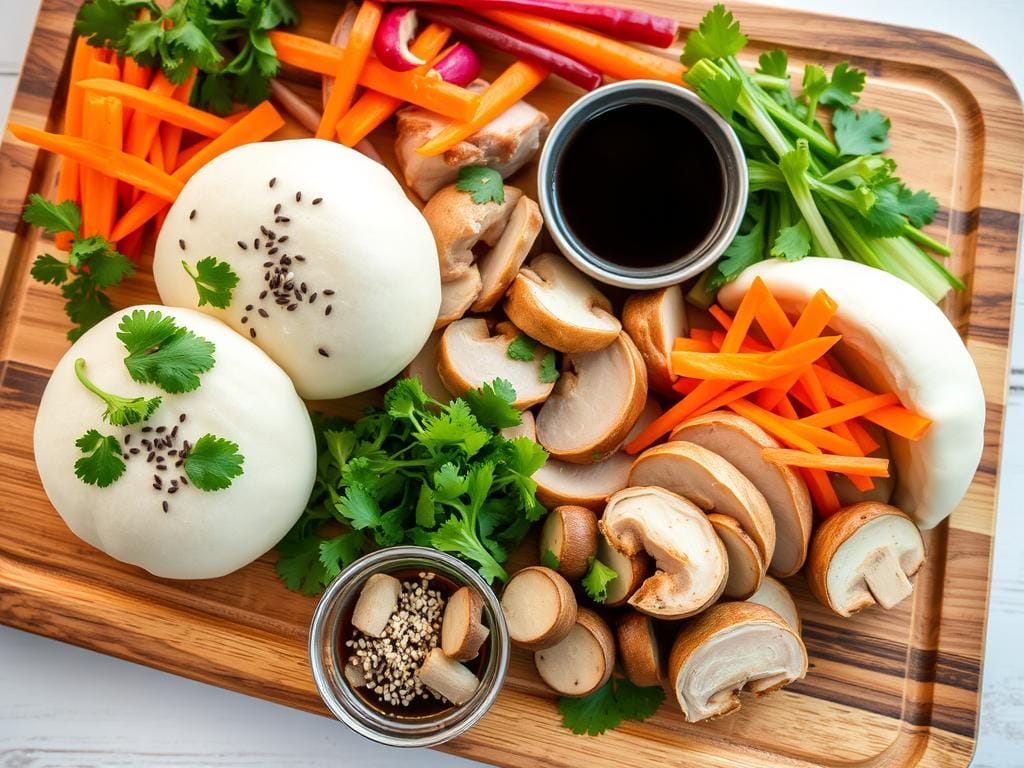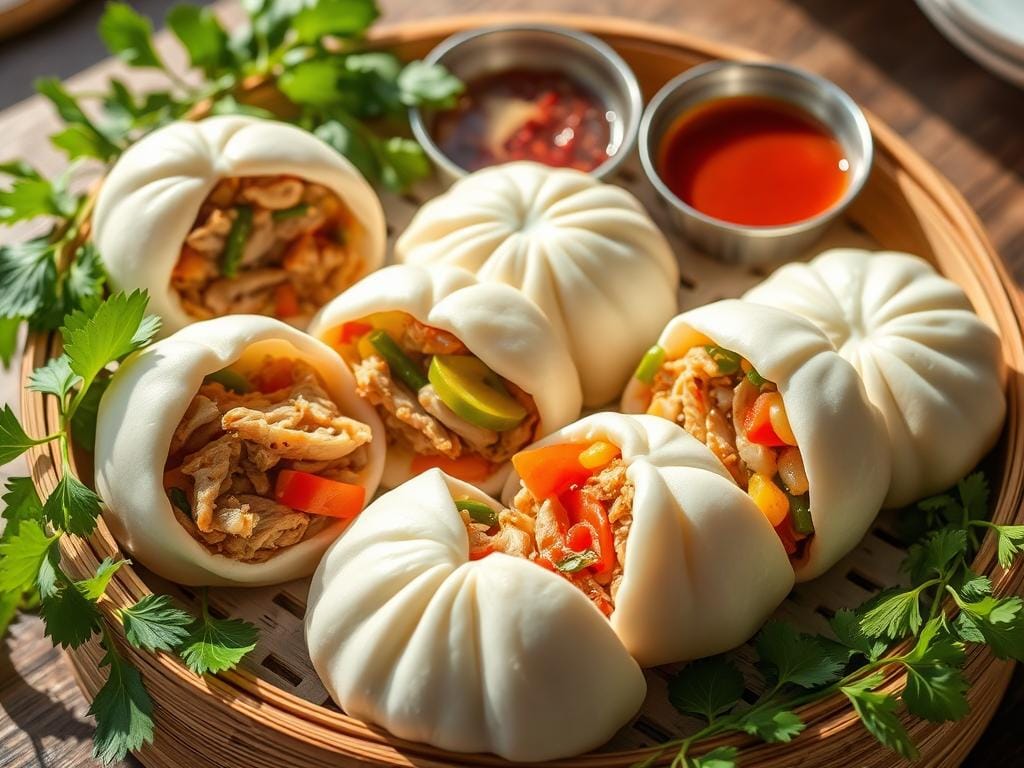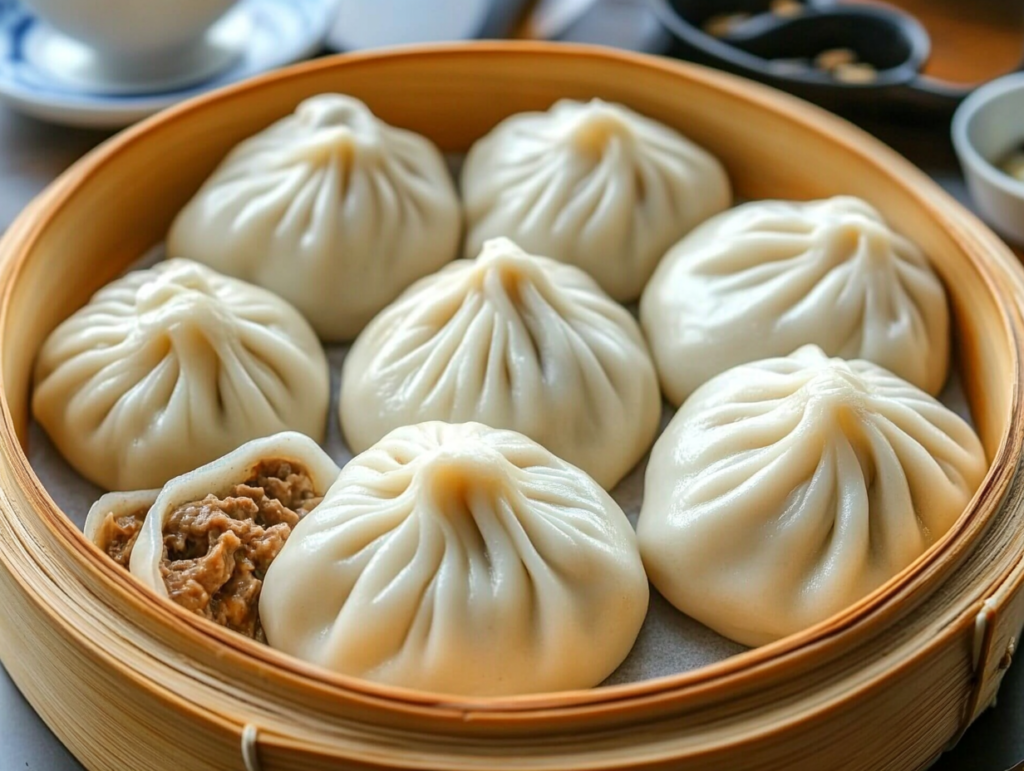Growing up, I always loved the comforting aroma of warm, steamed buns wafting through my neighborhood. These delightful buns, such as Chinese bao or Vietnamese banh bao, brought a sense of joy and connection to every gathering. As a passionate food lover, I’m thrilled to share the vibrant world of Asian steamed meat buns, along with their diverse and flavorful variations.
Key Takeaways
- Asian steamed meat buns, known as bao, nikuman, and banh bao, are popular street foods and dim sum items across various Asian cuisines.
- These buns feature a soft, fluffy dough exterior that encases savory fillings like chicken, or vegetables.
- Steaming is the traditional cooking method, resulting in a tender texture and aromatic flavor profile.
- Banh bao, the Vietnamese steamed pork buns, are considered one of the most delicious street foods in Vietnam.
- Diverse variations of steamed meat buns exist, including traditional, vegetarian, sweet, and specialty options.
Table of contents
- Key Takeaways
- What Are Asian Meat Buns?
- Different Types of Asian Meat Buns
- Key Ingredients in Meat Buns
- The History of Meat Buns
- Cooking Methods for Asian Meat Buns
- How to Choose the Right Meat Bun
- Making Asian Meat Buns at Home
- Popular Variations and Fillings
- Pairing Your Meat Buns
- Where to Find Asian Meat Buns in the U.S.
- The Future of Asian Meat Buns
- FAQ
What Are Asian Meat Buns?
Asian meat buns, also known as Chinese buns, pork buns, or steamed dumplings, are a favorite comfort food in Asia. They have a soft, leavened dough wrapper filled with tasty meat, usually pork. These buns are loved for their smell and feel, playing a big role in Asian food traditions, like in China, Japan, and Vietnam.
Definition and Overview
Asian meat buns, commonly known as “baos,” are steamed buns filled with a variety of savory ingredients. The dough, typically made from flour, yeast, water, and occasionally sugar or oil, creates a soft and pillowy texture. Fillings can range from pork and cabbage to chicken, mushrooms, or even vegetarian options. Steaming these buns ensures they remain warm and fluffy on the outside while keeping the filling juicy and flavorful on the inside.
Cultural Significance
These buns are deeply rooted in Asian cultures. They are comfort foods, bringing back memories and bringing families together. In many places, they’re served at special events, showing off culinary skills and wishing for good luck. They’re a big part of Asian cuisine, showing the region’s rich food heritage.
For more on Asian culinary traditions, explore Asian street foods and discover the diverse flavors of this cuisine.
| Ingredient | Quantity |
|---|---|
| Dry yeast | 2½ teaspoons |
| Pork loin | 1½ pounds |
| Sugar | ¼ cup |
| All-purpose flour | 2¼ cups |
| Garlic and ginger paste | 2 teaspoons |
| Vegetable oil | 3 tablespoons |
| Beaten egg | 1 |
| Honey | 2 tablespoons |
| Hoisin sauce | 2 tablespoons |
| Soy sauce | 2 tablespoons |
| Shaoxing wine | 1 tablespoon |
| Ground pepper | ½ teaspoon |
| Five spice powder | ½ teaspoon |
| Sesame oil | 1 teaspoon |
| Green onion | 2 sprigs, finely chopped |
| Egg wash | 1 egg |
| Oven temperature | 350°F |
| Baking time | 15-20 minutes |
| Dough rising time | 1 to 2 hours |
Different Types of Asian Meat Buns
Beyond the well-known char siu bao, Asian steamed buns offer a wide range of tasty options. These come from China, Japan, and Vietnam. Each has its own special flavors and ways of making.
Bao
Bao is the classic Chinese steamed bun. It has many fillings. Char siu bao is filled with tasty barbecue pork, loved in dim sum places.
Sweet buns like Hong dou bao with red bean paste and Chinese sugar buns with brown sugar or sesame are also popular. For a creamy treat, try Nai Wong Bao with custard filling.
Nikuman
In Japan, the steamed bun is called Nikuman. It’s soft and filled with minced pork and veggies. It’s a tasty savory treat.
Steamed sausage buns, or lop cheung bao, are another favorite. They’re filled with Chinese sausage, peppers, and mushrooms.
Banh Bao
Banh Bao from Vietnam is a pork bun with ground pork, Chinese sausage, and sometimes a quail egg. It shows Vietnam’s unique cooking style.
From the smoky char siu bao to the savory Nikuman and the Vietnamese Banh Bao, each bun is a delicious example of Asian creativity.
Key Ingredients in Meat Buns
The secret to making tasty Asian meat buns, like bao, nikuman, and banh bao, is in the ingredients. Both the dough and the filling are carefully chosen.
Dough Composition
The dough for these buns has all-purpose flour, yeast, sugar, and sometimes milk or oil. For instance, a bao dough recipe might use 250 grams of flour, 30 grams of sugar, and 4 grams of yeast. It also includes 20 ml of melted butter, 100 ml of warm water, 10 ml of milk, and a large egg. This mix makes the dough soft and fluffy, perfect for steaming.
Filling Varieties
- The fillings for meat buns can be different, but often include ground meat like chicken, or beef. They also have vegetables like cabbage or mushrooms, and seasonings like soy sauce, oyster sauce, and five-spice powder.
- A curry beef filling might have 275 grams of extra-lean minced beef, 120 grams of diced onion, cornstarch, sugar, salt, curry powder, turmeric, and vegetable oil.
- Vegetarian options are also loved, with fillings made from tempeh, hoisin sauce, and sriracha.
The success of a meat bun comes from balancing the soft dough with the tasty filling. This creates a wonderful bite with every steamed or baked bun.

The History of Meat Buns
The meat bun, or bao, has a long and fascinating history. It started in Northern China during the Three Kingdoms period (220-280 AD). These buns were filled with lamb and given to soldiers. As time went on, the bao spread across Asia, changing to fit local tastes and ingredients.
Origins in Asia
The bao’s story begins with Zhuge Liang, a military strategist. He created the dish to feed his troops. The mix of soft dough and tasty filling quickly became a hit, spreading across Asia.
Evolution Over Time
As the bao traveled, it changed to match the tastes of different places. In Japan, the nikuman came about during the Meiji period, influenced by China. In Vietnam, the banh bao was shaped by Chinese immigrants. Yet, the bao’s core idea of a tasty steamed bun stayed the same.
Today, the bao has earned a place on menus around the world, showcasing its versatility and timeless appeal. From classic pork buns to creative vegetarian options, the bao’s journey reflects the global rise of Asian cuisine and celebrates the importance of preserving traditional cooking methods.
Cooking Methods for Asian Meat Buns
There are two main ways to cook Asian meat buns: steaming and baking. Each method has its own benefits and gives the buns different textures. This lets you enjoy the full taste and variety of these buns.
To pair your buns with delicious condiments, try these easy homemade dipping sauces for added flavor.
Steaming: The Traditional Approach
Steaming is the traditional way to cook Asian meat buns, like how to steam bao. You put the buns in a steamer basket over boiling water. The steam cooks the buns for 10-15 minutes, making them soft and fluffy.
- Put the buns in a single layer in the steamer basket, so they don’t touch.
- Cover the pot and keep the steam steady for the cooking time.
- Check the buns often to make sure they’re fully cooked and puffed.
Baking: An Alternative Technique
Baked pork buns are also popular, like baked char siu bao. Baking gives the buns a crispy outside and a soft inside.
- Put the buns on a parchment-lined baking sheet, leaving space between them.
- Brush the tops with an egg wash for a shiny look.
- Bake at 375°F (190°C) for 15-20 minutes, until lightly browned.
Steaming and baking are both great ways to cook Asian buns. They let you choose your favorite texture and taste. Try both to find your favorite way to enjoy these tasty buns.
How to Choose the Right Meat Bun
When picking the best Asian meat buns, think about what you like. Do you like bold, savory flavors or something sweeter? Options range from pork and cabbage to sweet bean paste or fruit. Exploring different best Asian meat buns can help you find your favorite.
If you follow a special diet, look for options that fit. Many places offer vegetarian bao options with tofu or veggies. They also have gluten-free steamed buns made with special flours. This way, you can enjoy Asian meat buns while meeting your dietary needs.
Flavor Preferences
- Savory fillings like pork and cabbage
- Sweet options with bean paste or fruit
- Spicy buns infused with bold seasonings
Dietary Restrictions
- Vegetarian or vegan buns with tofu or veggie fillings
- Gluten-free steamed buns made with alternative flours
- Halal or kosher-certified meat buns
There are countless delicious Asian meat buns to try. Whether you want a classic pork bao or something new, you’ll find it. Every taste is catered to, making it easy to find your perfect bun.

Making Asian Meat Buns at Home
Making Asian meat buns at home is a fun cooking journey. You can pick your favorite flavors and ingredients. With the right tools and a simple recipe, you can make authentic bao or nikuman in your kitchen.
Essential Tools and Equipment
You’ll need a few important items to start. A steamer basket, whether bamboo or metal, is key for steaming the buns. You’ll also need bowls, a rolling pin, and a clean area to make your homemade bao recipe.
Step-by-Step Recipe
Making Asian meat buns is easy:
- Start by mixing flour, yeast, water, and other ingredients for the dough.
- Make the filling with ground meat, veggies, and spices.
- Shape the dough into buns, filling them with the meat mixture, and pleat the edges.
- Steam the buns in your bamboo steamer or steamer basket for 25-30 minutes until they’re fluffy and cooked.
The whole process, including resting and steaming, takes 2-3 hours. But the homemade buns are worth it. You can choose your fillings and ingredients for a tasty treat.
Popular Variations and Fillings
The world of Asian steamed meat buns, or baos, is full of flavors and fillings. You can find everything like chicken and mushroom options. Vegetarians also have plenty of choices.
For those who love bold flavors, try a beef teriyaki recipe for a similar savory and satisfying dish.
Chicken and Mushroom
The chicken and mushroom bao is a lighter choice. It has juicy chicken and fresh mushrooms for a unique taste. It’s great for those looking for a healthier or different bao option.
Vegetarian Options
- Mixed Vegetable Bao: A mix of carrots, cabbage, and bean sprouts makes a tasty and healthy filling.
- Tofu Bao: Tofu, seasoned with soy sauce and spices, is a tasty and filling vegetarian choice.
- Portobello Mushroom Bao: Portobello mushrooms add a meaty texture and strong flavor to this vegetarian bao.
The world of baos is always changing. Chefs and home cooks are trying new flavors. You can find everything from savory char siu to sweet red bean paste. This makes for a wide range of exciting tastes for everyone.
Pairing Your Meat Buns
Asian meat buns, like bao and banh bao, taste best with the right flavors and drinks. A refreshing cup of Chinese tea, like oolong or jasmine, is the traditional choice. These teas’ floral notes and mild taste balance the savory fillings of the buns.
But there are more ways to enjoy meat buns. Try them with tangy pickled veggies, like daikon radish or cucumbers. Or, pair them with a light congee or broth-based soup. This cleanses your palate between bites.
Recommended Dipping Sauces
Choosing the right dipping sauces can make your meat buns even better. Here are some classic options:
- Soy sauce
- Chili oil
- Black vinegar
- A mix of these for more flavor
These dips let you customize your meat buns’ taste. In a dim sum setting, meat buns are part of a variety of small dishes. This creates a joyful and balanced meal.
Where to Find Asian Meat Buns in the U.S.
If you’re craving authentic Asian meat buns, you’re in luck. They’re easy to find in the U.S. Look for them in Chinatown districts, top dim sum restaurants, and Asian grocery stores.
Want to explore more? Check out the best meats for Asian food to discover ingredients that enhance your favorite recipes.
Local Restaurants
Chinatown areas are home to many Chinese, Japanese, and Vietnamese restaurants. They serve freshly steamed meat buns with a variety of fillings. You can try classic pork and cabbage or chicken and mushroom options. Wow Bao is also a favorite for its quality bao.
Asian Markets
For a home-cooked meal, Asian grocery stores are the place to go. They offer frozen or pre-made buns that can be reheated. You’ll find both savory and sweet fillings. Some non-Asian stores also carry Asian-inspired buns, making them easier to find.
| Brand | Bun Variety | Calories per Bun | Availability |
|---|---|---|---|
| Wow Bao | Chinese-Style BBQ Pork Bao | 200 calories | Available in over 10,000 grocery stores nationwide |
| Wow Bao | Mongolian-Style Spicy Beef Bao | 210 calories | Available in over 10,000 grocery stores nationwide |
Whether you want a traditional Chinatown bao shop experience or prefer store-bought buns, you have many options. You can find these steamed treats all over the United States.
The Future of Asian Meat Buns
Asian cuisine’s popularity is growing worldwide, making meat buns even more appealing. Chefs are now using whole grain doughs and creative fillings. This change is making these tasty treats more exciting for everyone.
Today, bao creations are getting a modern twist. People are using lean proteins and healthy ingredients in their fillings. Chefs are also mixing traditional Asian flavors with international ones. This means you can find everything from Korean bulgogi to Mexican-inspired buns.
The future of Asian meat buns is looking bright. Expect to see doughs in new colors, like beetroot or spinach, which are both pretty and healthy. There’s also a big push for vegan and vegetarian options. This means you’ll find meatless buns that taste great and fit your lifestyle.
For an upscale twist, pair steamed buns with elegant seafood recipes for a fusion-inspired dining experience.
FAQ
What Are Chinese Meat Buns Called?
Chinese meat buns are commonly known as Baozi (包子). These are soft, steamed buns typically filled with savory ingredients such as
beef, chicken, or vegetables. The filling can be seasoned with soy sauce, scallions, and other aromatics.
What Is Another Name for Meat Buns?
Another name for meat buns includes:
- Bao – A shortened and casual name for “baozi,” widely used internationally.
- Dumpling Bun – Some may refer to bao as dumpling-like due to its dough and filling.
- Steamed Buns – A more general term highlighting the cooking method.
- Nikuman – The Japanese term for steamed meat buns inspired by Chinese baozi.
What Is the Word for a Chinese Bun?
The general word for a Chinese bun is “Bao” (包) or “Baozi” (包子).
- Bao refers to any stuffed or plain bun, steamed or baked.
- Mantou (馒头) is another term specifically for plain steamed buns without fillings, often eaten in northern China.
What Is a Vietnamese Bun Called?
In Vietnamese cuisine, the word “Bún” refers to rice vermicelli noodles, not buns.
- Dishes like Bún Chả (grilled pork with noodles) and Bún Bò Huế (spicy beef noodle soup) feature these noodles.
If referring to a “bun” similar to bao, the Vietnamese equivalent would be Bánh Bao.
- Bánh Bao are Vietnamese steamed buns filled with ingredients like mushrooms, quail eggs, and vermicelli, inspired by the Chinese baozi.
In summary:
- Chinese meat buns: Baozi or Bao.
- Other names: Steamed buns, dumpling buns, Nikuman.
- General Chinese buns: Bao or Mantou.
- Vietnamese buns: Bánh Bao for filled buns; Bún refers to rice noodles.

